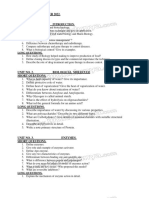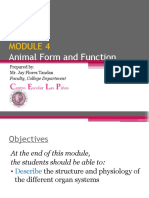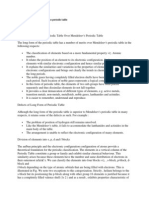Chapter#5 Variety of Life
Chapter#5 Variety of Life
Uploaded by
trinitystore483Copyright:
Available Formats
Chapter#5 Variety of Life
Chapter#5 Variety of Life
Uploaded by
trinitystore483Original Title
Copyright
Available Formats
Share this document
Did you find this document useful?
Is this content inappropriate?
Copyright:
Available Formats
Chapter#5 Variety of Life
Chapter#5 Variety of Life
Uploaded by
trinitystore483Copyright:
Available Formats
Biology Notes FSc PART-I (Variety of Life) Dr. Mahtab Aslam Khan (HOD Bio.
PGC Bhakkar)
Chapter # 5 VARIETY OF LIFE
WHAT IS SPECIES?
A species is a group of natural population which can interbreed freely among each
other and produce fertile offsprings similar to themselves, but are reproductively
isolated from all other such groups in nature.
However “interbreeding” cannot be used as a criterion for species of asexually reproducing
organisms.
CHARACTERISTICS OF A SPECIES:
Each species possessed its own distinct structural, ecological and behavioral characteristics.
Species are independent evolutionary units.
Different species do not exchange genes between them.
CLASSIFICATION:
The grouping of organisms on the basis of homology, comparative biochemistry,
cytology and genetics is known as classification.
Biologists have classified all living things into groups showing similarities. All organisms are
related to one another at some point in their evolutionary histories. However, some organisms are
more closely related than others.
Example: Sparrows are more closely related to pigeons and both are different from insects.
NEED OF CLASSIFICATION:
There is huge diversity of organisms on planet earth. One and a half million species of animals and
over a half million species of plants are known.
To understand such a large collection of organisms with dissimilar forms, classification is needed.
SIMPLE TYPE OF CLASSIFICATION:
Initially the classification was based on the appearance or morphology of plants and animals
For example we could classify flowering plants according to their colour, height, or any other
character. This type of classification is not important because it does not provide any information
about the basic differences and similarities among different individuals. But with advancement in
Punjab Colleges Bhakkar Campus Page 1
Biology Notes FSc PART-I (Variety of Life) Dr. Mahtab Aslam Khan (HOD Bio. PGC Bhakkar)
the knowledge of cytology, comparative biochemistry, physiology, genetics and molecular biology
the classification of organism has been modified.
LEVELS OF CLASSIFICATION:
Levels of classifications start from larger groups such as kingdom and are divided into smaller
groups upto species level.
Kingdom: Since long the living things are divided in two kingdoms: plants and animals.
Phylum/Division: kingdom is divided into smaller groups called phyla (also divisions for
plants, algae and fungi).
Class: A phylum is divided into classes.
Order: Classes are divided into orders.
Family: An order is divided into families.
Genus: A family contains related genera
Species: A genus is composed of one or more species. Species is the basic
unit of classification.
CLASSIFICATION OF CORN:
Zea
NOMENCLATURE
The process of giving the scientific names to organisms which consists of two words, the genus and
species, is called binomial nomenclature.
Punjab Colleges Bhakkar Campus Page 2
Biology Notes FSc PART-I (Variety of Life) Dr. Mahtab Aslam Khan (HOD Bio. PGC Bhakkar)
DISCOVERY:
Carlous Linnaeus (1707-1778), a Swedish botanist during the 18th century, devised a system
for naming and classifying all the organisms known to him.
Internationally Known: His system is used today internationally.
Discarded common Names: He discarded the common names of plants and gave each
one a scientific name.
Latin words: He took the scientific name from Latin word.
List of Plants: Linnaeus publishes the list of scientific names of plants in 1753.
List of Animals: His system spread and became so popular that he used it in naming
animals and published his list in 1758.
Two Parts: The scientific name of each plant had two parts. Genus and species.
Reference: Usually, the name referred to some characteristics of the organisms or the
person who collected it.
EXAMPLES OF SCIENTIFIC NAMES:
The first word of scientific name is genus and always begins with a capital letter. The second word
is species which follows the generic name and begins with small letter.
Scientific name for different organisms is as:
Onion Allium cepa,
Amaltas Cassia fistula
Man Homo sapiens.
Potato Solanum tuberosum
Brinjal Solanum melangena.
The same generic name for potato and brinjal relects close relationship between these two-species.
PROBLEMS OF COMMON NAMES:
Common names have no scientific basis. Common names had long caused confusion. From the
earliest times plants and animals have been given common names by the people. Since no system
was used in choosing common names, in many cases, various regions had their own
names for the same plant or animal.
Punjab Colleges Bhakkar Campus Page 3
Biology Notes FSc PART-I (Variety of Life) Dr. Mahtab Aslam Khan (HOD Bio. PGC Bhakkar)
Different names of same organisms:
Onion: If we take the example of onion, the common urdu name is „Piyaz‟ but in different
regions of Pakistan it is also known as „ganda‟ or „bassal‟ or „vassal‟. In different countries it
would have another set of names.
Amaltas: has also different common names as argvad, gurmala, golden shower, purging
cassia. Thus the same plant may have diferent names.
Single name of different plants or animals:
In some cases, a single name refers to several different plants or animals.
Blue Bell: Dozen of plants with bell shaped flowers are called „blue bells‟.
Black Bird: The word „black bird‟ would mean a crow as well as a raven.
Unrelated names:
To a biologist, a fish is a vertebrate animal with a backbone, fins and gills. But the word fish is
attached with unrelated animals such as „silver fish‟ which is an insect, and a „cray fish‟, „jelly fish‟
and „starish‟ are all invertebrates and do not fit the biologist‟s definition of a fish.
TWO TO FIVE KINGDOM CLASSIFICATION SYSTEMS
Different classification systems recognize two to five kingdoms.
TWO KINDGOME SYSTEM:
For centuries, the living organisms have been classified into two kingdoms, plants and animals.
Plants (Autotrophs):
Plants can prepare their own food from simple inorganic material and store energy and are called
autotrophs. Bacteria were also included in plants.
Animals (Heterotrophs):
Animals can not synthesize their own food from simple inorganic material and depend for their
food either on autotrophs or on decaying organic matter and are also known as heterotrophs.
Punjab Colleges Bhakkar Campus Page 4
Biology Notes FSc PART-I (Variety of Life) Dr. Mahtab Aslam Khan (HOD Bio. PGC Bhakkar)
THREE KINGDOM SYSTEM:
Protista:
In 1866, Ernst Hackel proposed a third kingdom protista to accommodate Euglena like organisms
and bacteria. Many biologists found this system satisfactory.
Problems of three kingdom system:
1. Euglena:
Some biologists disagreed with three kingdom system for many unicellular organisms like
Euglena that have both plant like (presence of chlorophyll) and animal like (lack of cell wall)
characters.
2. Difference between prokaryotic and eukaryotic cells:
It ignores the differences between prokaryotic and eukaryotic cells.
3. Fungi:
Some biologists also disagree about the classification of fungi, such as bread mold, yeast
and mushrooms, which resemble plants in many ways but are not autotrophs. Fungi are
special forms of heterotrophs that obtain energy and structural material by breaking down
(decomposing) and absorbing food substances from the surroundings, and possess chitin as
a major structural component in their cell walls.
FIVE KINGDOM SYSTEM:
The five kingdom system, was proposed by Robert Whittaker (1969). It is relatively recent system
of classification.
Kingdoms:
1. Kingdom Prokaryotae (Monera): It includes the prokaryotic unicellular organisms
such as bacteria.
2. Kingdom Protoctista (Protista): All eukaryotes that did not fit the definition of plants,
fungi or animalia were included in Protista. Most Protists are unicellular forms, but this
kingdom also includes relatively simple multicellular organisms that are believed to be
direct descendants of unicellular protists. It includes the eukaryotic unicellular organisms
such as Euglena and Amoeba.
3. Kingdom Plantae: It includes the eukaryotic multicellular autotrophs such as plants.
4. Kingdom Fungi: It includes the eukaryotic multicellular reducers e.g. mushrooms.
Punjab Colleges Bhakkar Campus Page 5
Biology Notes FSc PART-I (Variety of Life) Dr. Mahtab Aslam Khan (HOD Bio. PGC Bhakkar)
5. Kingdom Animalia: It includes the eukaryotic multicellular consumers/heterotrophs e.g.
animals.
Cellular Basis:
This system of classification is based on three different levels of cellular organization.
1. Unicellular prokaryotes.
2. Unicellular eukaryotes.
3. Multicellular eukaryotes.
Modes of Nutrition:
This kingdom system of classification is also based on different modes of nutrition.
1. Photosynthesis (autotrophs).
Plants are autotrophic in nutritional mode, making their own food by photosynthesis such
as mosses, ferns, lowering plants.
2. Absorption (decomposers/reducers).
Fungi are heterotrophic organisms that are absorptive in their nutritional mode. Most fungi
are decomposers that live on organic material, secrete digestive enzymes and absorb small
organic molecules which are produced by digestion.
3. Ingestion (heterotrophs).
Animals live mostly by ingesting food and digesting it within specialized cavities. They lack
cellulose and show movements for example birds and reptiles.
E-Chatton (1937):
He suggested differentiating terms procariotique (from Greek pro, meaning before, and karyon,
meaning nucleus) to describe bacteria and blue-green algae, and the term eu-cariotique (from
Greek eu, mean true) to describe animal and plant cells.
Lynn Margulis and Karlene Schwartz (1988):
They modified five kingdom classification of Whittaker by considering cellular organization, mode
of nutrition, cytology, genetic and organelles of symbiotic origin (mitochondria , chloroplast).
Punjab Colleges Bhakkar Campus Page 6
Biology Notes FSc PART-I (Variety of Life) Dr. Mahtab Aslam Khan (HOD Bio. PGC Bhakkar)
(Relationship of five kingdom)
(Five kingdom classification by Whittaker)
Punjab Colleges Bhakkar Campus Page 7
Biology Notes FSc PART-I (Variety of Life) Dr. Mahtab Aslam Khan (HOD Bio. PGC Bhakkar)
VIRUSES
DEFINITION:
The word virus is derived from Latin word venome which means poisonous fluid. Viruses can be
defined as non cellular infectious entities which contain either RNA or DNA, normally encased in
proteinaceous coat, and reproduce only in living cells. Viruses utilize the biosynthetic machinery of
the host for its own synthesis and then transfer themselves efficiently to other cells.
VIROLOGY: The branch of biology which deals with the study of viruses is known as virology.
HISTORY:
About a century ago at the time of Louis Pasteur (1822-1895) and Robert Koch (1843-1910), the
word “virus” was generally referred to as a poison associated with disease and death. Now viruses
are recognized as particles of nucleic acid often with a protein coat.
DISEASES OF VIRUSES:
Some viral diseases have been known for centuries. Viruses cause many diseases such as influenza,
hepatitis, small pox and AIDS.
HISTORY OF VIRUSES:
Edward Jenner (1796):
Vaccination of James:
In 1796, Edward Jenner removed the material from cowpox lesion on the hand of milkmaid and
injected it into 8 years old boy James. After six weeks the boy was inoculated with pus from a small
pox victim, but the boy did not develop small pox disease.
Vaccination of 23 persons:
Later, Jenner used material from cowpox lesions for vaccination and successfully vaccinated 23
persons. As the material he used was obtained from cow (latin vacca), the term vaccination was
used by Louis Pasteur for inoculation against disease.
First disease to have effective method of prevention: The first infectious disease against
which effective method of prevention was developed was a viral disease.
Punjab Colleges Bhakkar Campus Page 8
Biology Notes FSc PART-I (Variety of Life) Dr. Mahtab Aslam Khan (HOD Bio. PGC Bhakkar)
Charles Chamberland (1884):
One of Pasteur‟s associates, Charles Chamberland, found that bacteria can not pass through
porcelain filters, while agent responsible for rabies (a disease which is transferred to human by
bites of rabid dogs, foxes, cats, bats and other animals) can pass through these filters. As in those
days the word virus was loosely used to describe any toxic substance that caused disease, those
unseen filterable agents of disease were described as filterable viruses.
Ivanowski (1892):
In 1892, Ivanowski discovered that the agent which caused tobacco mosaic disease was filterable.
He obtained filtrate free of bacteria from ground up leaves of infected plants and placed it on
healthy leaves of tobacco. He observed that filtrate produced the disease in healthy plants.
Foot and mouth disease (1898), Yellow fever disease (1901):
Presence of similar filter-passing, ultramicroscopic agents was seen in the victims of many diseases,
including foot and mouth disease (1898) and yellow fever (1901).
Twort (1915):
Twort in 1915 and D‟Herelle in 1917 independently discovered bacteriophages, viruses that infect
bacteria. Twort observed that bacteria colonies sometimes undergo Lysis (dissolved and
disappeared) and that this lysis can be transferred from one colony to other. Even highly dilute
material from lysed colony can transfer the lytic effect.
However, heating the filtrate destroyed its lytic property. From these observations he
concluded that lytic agent might be a virus.
D’Herelle (1917):
D‟Herelle rediscovered the same phenomenon as Twort did and used the word bacteriophages
meaning “bacteria eater”.
Stanley (1935):
The filterable agents were first purified in 1935, when Stanley was successful in crystallizing
the tobacco mosaic virus. Chemical analysis of these particles showed that they contained
only nucleic acid and protein. This suggested that, unlike other forms, viruses are of simple
chemical composition.
Punjab Colleges Bhakkar Campus Page 9
Biology Notes FSc PART-I (Variety of Life) Dr. Mahtab Aslam Khan (HOD Bio. PGC Bhakkar)
CHARACTERISTICS OF VIRUSES:
SIZE:
Viruses are extremely small infectious agents, which can only be seen under an electron
microscope. They range in size from 250 nanometer (nm) of poxviruses to the 20 nm of
parvoviruses.
FILTERABLE:
Viruses are 10 to 1000 times smaller than most bacteria, so they can pass through the pores of
filter, from which bacteria cannot pass.
OBLIGATE INTRACELLULAR PARASITE:
Viruses cannot be grown on artificial media. They can reproduce only in animal and plant cells or
in microorganisms. They reproduce by replication (a process by which many identical copies of
virus are formed). Thus the viruses are obligate intracellular parasites.
HOST DEPENDENT METABOLISM:
Viruses lack metabolic machinery for the synthesis of their own nucleic acid and protein. They
depend on the host cell to carry out these vital functions.
DISEASES AND RESISTANCE:
During reproduction in the host cells, viruses may cause disease. All viruses are generally resistant
to broad range of available antibiotics such as penicillin, streptomycin and others.
STRUCTURE OF VIRUSES:
NUCLEOCAPSID: The complete, mature and infectious particle is known as virion. The virions
are composed of a central core of nucleic acid, either DNA or RNA, which is also known as the
genome and is surrounded by a protein coat, the capsid. Capsid gives definite shape to virion.
CAPSOMERES:
Capsid is made up of protein subunits known as capsomeres. The number of capsomeres is
characteristics of a particular virus.
Example:
Herpes Virus: It has 162 capsomeres in the capsid
Adenovirus: It has 252 capsomeres in the capsid. It causes some common colds.
Punjab Colleges Bhakkar Campus Page 10
Biology Notes FSc PART-I (Variety of Life) Dr. Mahtab Aslam Khan (HOD Bio. PGC Bhakkar)
ENVELOPE:
In some animal viruses the nucleocapsid (nucleic acid and capsid) is covered by another
membrane which is derived from the host cell. This covering of nucleocapsid is known as the
envelope. Non enveloped viruses are known as naked virions.
SHAPES:
SHAPES OF BACTERIOPHAGES:
Bacterio-phages occur in two structural forms:
Cubical symmetry:
In general appearance cubical phages are regular solid or icosahedral having 20 faces.
Helical symmetry:
Helical phages are rod shaped
Many phages consist of head and tail. In those cases heads are polyhedral but tails are rod
shaped.
SHAPES OF ANIMAL AND PLANT VIRUSES:
Animal and plant viruses may be polyhedron (having many sides), helical (Spiral), enveloped or
complex.
(Different types of viruses)
Punjab Colleges Bhakkar Campus Page 11
Biology Notes FSc PART-I (Variety of Life) Dr. Mahtab Aslam Khan (HOD Bio. PGC Bhakkar)
WHAT ARE PRIONS?
Prions are least understood microorganisms which are infectious proteins. They were most recently
discovered in 1983.
Composition:
Their nature is very controversial. They are composed of protein only that contains the information
that codes for their own replication. All other organisms contain their genetic information in
nucleic acid (DNA or RNA).
Diseases:
Prions are responsible for “mad cow infection” and “mysterious brain infection in man”.
LIFE CYCLE OF BACTERIOPHAGES:
BACTERIOPHAGES:
The viruses which infect bacteria such as Escherichia coli are called bacteriophages.
T-PHAGES:
Bacteriophages are also simply known as phages. Earlier researches on bacteriphages were mainly
on limited number of phages that infect these bacteria. Of these the best known phages are T
phages (T for type).
Mostly used T-phages:
Among T phages, the T2 and T4 phages are mainly used in phage studies.
STRUCTURE OF T-PHAGE:
The overall structure of T4, studied with electron microscopy, resembles that of tadpole consisting
of following parts:
Head:
The head is an elongated pyramidal (having two triangular structures with common base),
hexagonal, prism -shaped structure, to which straight tail is attached. Within the head double
stranded DNA molecule is present.
Punjab Colleges Bhakkar Campus Page 12
Biology Notes FSc PART-I (Variety of Life) Dr. Mahtab Aslam Khan (HOD Bio. PGC Bhakkar)
TAIL:
The structure of phage tail is more complex than head. It consists of following parts:
Tail sheath: The outer most tube of tail present between head and tail fibers is called tail
sheath.
Collar: At one end, the tail is connected with head through a structure called collar.
End plate: At other end, the tail is connected with tail fibers with a structure called end
plate.
Tail Core: A tube of distinct protein which is enclosed by tail sheath is called tail core.
Tail fibers: Tail fibers are the structures which are attached with end plate. are attached,
which are the structures for attachment. The volume of the phage is about
1/1000 of the host.
(A bacteriophage)
LIFE CYCLE OF BACTERIOPHAGE:
The bacteriophage replicates only inside the bacterial cell. The different steps of the life cycle are
as:
Punjab Colleges Bhakkar Campus Page 13
Biology Notes FSc PART-I (Variety of Life) Dr. Mahtab Aslam Khan (HOD Bio. PGC Bhakkar)
LYTIC CYCLE:
Attachment (adsorption) Phage attaches at receptor site on the cell wall of bacterium. During
attachment, week chemical union between virion and receptor site takes place.
Penetration:
The tail of bacteriophage releases the enzyme called lysozyme to dissolve a portion of the
bacterial cell wall. The tail sheath contracts and tail core is forced into the cell through cell wall and
cell membrane. The virus injects its DNA into the cell same as the syringe is used to inject the
vaccine.
The protein coat, which forms the phage head and tail structure of virus remains outside the cell.
Many animal viruses, however enter the host cell as a whole.
(Phage injecting its DNA into host)
Multiplication:
Immediately after entering the host cell , the viral nucleic acid takes the control of the host‟s
biosynthetic machinery and induces the host cell to synthesize necessary viral components (dna,
proteins), and starts multiplying.
Lysis:
About 25 minutes after initial infection, approximately 200 new bacteriophages are formed inside
the bacterial cell. The result is bacterial cell bursts, i.e. it undergoes lysis. Newly formed phages are
released to infect the other bacteria and start lytic cycle.
Lytic phage:
The phage which causes lysis of the host cell is known as lytic or virulent phage. All infections of
bacterial cells by phages do not result in lysis.
Punjab Colleges Bhakkar Campus Page 14
Biology Notes FSc PART-I (Variety of Life) Dr. Mahtab Aslam Khan (HOD Bio. PGC Bhakkar)
LYSOGENIC CYCLE:
Lysogeny:
In some cases when the viral DNA is penetrated into bacterium, it becomes incorporated into the
bacterial chromosome instead of taking over the control of host‟s machinery. Phage in this state is
called prophage and this process is known as lysogeny.
During lysogeny, the bacterium continues to live and reproduce normally. Viral DNA being the part
of bacterial chromosome passes to each daughter cell in all successive generations.
Resistant to Infection:
Lysogenic bacteria are resistant to infection by the same or related phages.
Temperate phage: The phage which causes lysogeny is called temperate (lysogenic) phage.
Induction:
Some times, the viral DNA gets detached from the host‟s chromosome and lytic cycle starts. This
process is called induction.
Punjab Colleges Bhakkar Campus Page 15
Biology Notes FSc PART-I (Variety of Life) Dr. Mahtab Aslam Khan (HOD Bio. PGC Bhakkar)
(Replication of Bacteriophages)
CLASSIFICATION OF VIRUSES:
On the basis of morphology:
On the basis of morphology viruses are classified into rod shaped (T.M.V), spherical (poliovirus)
and tadpole like bacteriophage viruses etc.
On the basis of Nucleic acids:
Nucleic acid properties are most important for classifying plant, animal and
bacterial viruses. The viruses may be DNA or RNA on the basis of genetic material.
Punjab Colleges Bhakkar Campus Page 16
Biology Notes FSc PART-I (Variety of Life) Dr. Mahtab Aslam Khan (HOD Bio. PGC Bhakkar)
On the basis of Envelope:
If the viruses are without covering of their nucleocapsids, these are called naked viruses. If these
are with outer covering called enveloped or complex virues.
SOME VIRUS DISEASES:
There are many diseases which are caused by viruses. The diseases which have been or
common in Pakistan are as follows:
SMALL POX:
Causative agent: Smallpox is caused by pox viruses (the DNA enveloped virus).
History: It is an ancient disease that is known to have occurred as epidemic in China as early as
the twelfth century B.C. Until the early twentieth century, small pox was a common disease
throughout the world.
Symptoms: In small pox, raised fluid-filled vesicles are formed on the body which later on
become pustules and form pitted scars. These pitted scars are also called the pocks.
Control: By 1950‟s, immunization and other control measures had largely decreased the danger,
but it is still present in the third world countries where many people are affected. In 1980, it was
declared by World Health Organization that small pox has been eradicated from the world.
HERPES SIMPLEX:
Causative agent: It is caused by Herpes virus (DNA virus). It is naturally occurring
disease of mankind.
Symptoms: In this disease, vascular lesions in the epithelial layers of ectodermal tissues are
formed.
Infected body areas: Most commonly this disease occurs in the mouth, on the lips, and at other
skin sites.
INFLUENZA:
Causative agent: It is caused by Influenza viruses that is an enveloped RNA virus.
Spread: Influenza is wide spread disease in man and occurs in epidemic form.
Punjab Colleges Bhakkar Campus Page 17
Biology Notes FSc PART-I (Variety of Life) Dr. Mahtab Aslam Khan (HOD Bio. PGC Bhakkar)
MUMPS AND MEASLES:
Causative agent:
It is caused by Mumps and Measles viruses which belong to group paramyxoviruses. They are large,
enveloped, RNA viruses.
Spread:
Mumps is highly contagious, wide spread, but seldom fatal. Measles is one of the commonest
diseases of the childhood and adult human population is equally susceptible the world over.
Control: About 60% of adults are immune to it. This disease develops immunity in its victim.
POLIO:
Causative agent: Poliomyelitism is caused by polio virus. The polioviruses are the smallest
known viruses and contain RNA in spherical capsid.
Spread: It is found all over the world. It occurs mostly in childhood. The age at which primary
infection occurs varies with social and economic factors.
(Some common human viral diseases)
Punjab Colleges Bhakkar Campus Page 18
Biology Notes FSc PART-I (Variety of Life) Dr. Mahtab Aslam Khan (HOD Bio. PGC Bhakkar)
RETROVIRUSES:
The viruses which are associated with tumor production in a number of animal species, such as
fowl, rodents and cats, are known as retroviruses. RNA tumor viruses have been known for many
years. These viruses are widely distributed in nature.
EXAMPLE: The most familiar of retroviruses is the human immunodeficiency virus (HIV)
which causes acquired immune deficiency syndrome (AIDS).
STRUCTURE AND SHAPE:
The single stranded RNA tumor viruses, which also include retroviruses (oncoviruses), are
spherical in form, about 100nm in diameter and enveloped by host plasma membrane.
NON-SPECIFIC: A few retroviruses are non-specific that is they can infect any cell.
HOST SPECIFIC: Most of them can infect only host cells that possess required receptors.
Example:
In the case of AIDS virus, the host cell possesses a receptor that allows the viral adsorption and
penetration in several types of leukocytes (white blood cells) and tissue cells.
REVERSE TRANSCRIPTASE:
The retroviruses have a special enzyme called reverse transcriptase, which can convert a single -
stranded RNA genome into double stranded viral DNA.
PROVIRUS:
The DNA of retrovirus after infection in host cells when becomes incorporated into its genome, it is
called as a provirus. Provirus can can be passed on to daughter cells. In this way, some of
retroviruses can convert normal cells into cancer cells.
ACQUIRED IMMUNE DEFICIECY SYNDROME (AIDS):
DISCOVERY IN HOMOSEXUALS:
The AIDS was reported by some physicians in young patients with homosexual activity early in
1980‟s. They had one or more of complex symptoms such as:
severe pneumonia
a rare vascular cancer
Punjab Colleges Bhakkar Campus Page 19
Biology Notes FSc PART-I (Variety of Life) Dr. Mahtab Aslam Khan (HOD Bio. PGC Bhakkar)
sudden weight loss
swollen lymph nodes
General loss of immune functions. All these young patients were homosexuals.
DISCOVERY IN NON-HOMOSEXUALS:
Soon after the disease was discovered in non-homosexual patients who were given blood (blood
transfusion) or blood products.
CAUSATIVE AGENT:
In 1984 the agent causing the disease was identified by research
teams from Pasteur Institute in France and National Institute of health in USA. In 1986 the virus
was named as Human Immunodeficiency Virus (HIV).
INFECTION OF T-LYMPHOCYTES:
The major cell infected by HIV is the helper T-lymphocyte, which is major component of immune
system. As the HIV infection continues in the host, the decrease of helper T-lymphocytes results in
failure of the immune system and the infected person becomes susceptible to other diseases. Cells
in central nervous system can also be infected by HIV.
HOST SPECIFIC:
Recent studies on HIV reveal that the virus infects and multiplies in monkey but does not cause
disease in them, which means that HIV is host specific.
TRANSMISSION:
The HIV is transmitted by intimate sexual contact, contact with blood and breast feeding.
Healthcare workers can also acquire HIV during professional activities.
CONTROL:
Avoiding the direct contact with HIV is important measure for preventing the disease. Prevention
of‟ intravenous drugs with common syringes and use of sterile needles/syringes and utensils is
important.
VACCINATION:
Now vaccine against HIV has been synthesized and its experimental administration in humans
started in early 2001 in South Africa.
Punjab Colleges Bhakkar Campus Page 20
Biology Notes FSc PART-I (Variety of Life) Dr. Mahtab Aslam Khan (HOD Bio. PGC Bhakkar)
Human immunodeficiecy virus (HIV)
(Infection cycle of HIV)
Punjab Colleges Bhakkar Campus Page 21
Biology Notes FSc PART-I (Variety of Life) Dr. Mahtab Aslam Khan (HOD Bio. PGC Bhakkar)
HEPATITIS:
Hepatitis is an inflammation of the liver. It is usually caused by viral infection, toxic agents or
drugs.
It is characterized by jaundice, abdominal pain, liver enlargement, fatigue and sometimes fever. It
may be mild or can be acute and can lead to liver cancer.
TYPES OF HEPATITIS:
The different types of viral hepatitis are: Viruses of hepatitis A, B and C are better known.
HEPATITIS A (formerly called infectious hepatitis).
Causative agents: Hepatitis A virus (HAV) is an RNA virus (non enveloped). It causes mild
short term, less virulent disease.
Transmission: It is transmitted by contact with feces from infected individuals.
Vaccination: Vaccine is also available for HAV.
HEPATITIS B (serum hepatitis).
Causative agent:
Hepatitis B (HBV) is the second major form of hepatitis. It is caused by DNA virus which is very
common in Asia, China, Philippines, Africa and the Middle East.
Transmission:
Hepatitis B is transmitted by the exchange of body fluids, for example blood serum, breast milk and
saliva, from mother to child during birth or afterward and by sexual contact.
Symptoms:
During acute attacks of Hepatitis B, fatigue, loss of appetite and jaundice are reported.
Treatment:
Infected persons can recover completely and become immune to the virus. Genetically engineered
vaccine is available for HBV.
Punjab Colleges Bhakkar Campus Page 22
Biology Notes FSc PART-I (Variety of Life) Dr. Mahtab Aslam Khan (HOD Bio. PGC Bhakkar)
HEPATITIS C (formerly called non-A, non-B hepatitis)
Causative agent:
It is caused by Hepatitis C virus (HCV) which is RNA enveloped virus. It causes infusion hepatitis,
which is less severe than hepatitis A or hepatitis B.
Transmission:
It is transmitted through blood transfusion, from mother to child during and after pregnancy and
by sexual contact. Hepatitis C often leads to chronic liver disease.
Vaccination: Vaccine is not available for HCV.
HEPATITIS D (delta hepatitis): It may cause acute or chronic inflammation of liver.
HEPATITIS E
Transmission:
Its virus is transmitted through the feces of an infected person. Most recent work of Halbur and
coworker (2001) reveals that pig could be the source of infection of hepatitis E.
HEPATITIS F & G
These are caused by viruses yet unidentified.
People with chronic hepatitis infection are at the risk of liver damage. Hepatitis can be controlled
by adopting hygienic measures, with routine vaccination and screening of blood/ organ/ tissue of
the donor.
Punjab Colleges Bhakkar Campus Page 23
You might also like
- Foxhugh Superpower List NumberedDocument11 pagesFoxhugh Superpower List NumberedHugh Fox III100% (3)
- 1913 Anonymous Private Lessons in The Cultivation of Sex Force PDFDocument202 pages1913 Anonymous Private Lessons in The Cultivation of Sex Force PDFChandandeep Singh100% (2)
- CBSE Chapterwise Objective MCQs Physics, Chemistry, Biology, English, PH Ed - JEEBOOKS - inDocument305 pagesCBSE Chapterwise Objective MCQs Physics, Chemistry, Biology, English, PH Ed - JEEBOOKS - invenom eNo ratings yet
- Written/Composed By: - SHAHZAD IFTIKHAR Contact # 0313-5665666 WebsiteDocument26 pagesWritten/Composed By: - SHAHZAD IFTIKHAR Contact # 0313-5665666 WebsiteUmme Abdullah50% (2)
- Durdans Lab - Panadura MR .Josep Perera: Location:: Time:: 3:26PM Patient Name / 76 Y M Age / GenderDocument1 pageDurdans Lab - Panadura MR .Josep Perera: Location:: Time:: 3:26PM Patient Name / 76 Y M Age / GenderHush PereraNo ratings yet
- Chapter 7 Biology 1st Year - Prof. Ijaz Ahmed Khan Abbasi (Lecturer Biology PGC) Notes - MDCAT by FUTURE DOCTORS - Touseef Ahmad Khan - 03499815886Document19 pagesChapter 7 Biology 1st Year - Prof. Ijaz Ahmed Khan Abbasi (Lecturer Biology PGC) Notes - MDCAT by FUTURE DOCTORS - Touseef Ahmad Khan - 03499815886Tauqeer AhmadNo ratings yet
- Chapter 5 Biology 1st Year - Prof. Ijaz Ahmed Khan Abbasi (Lecturer Biology PGC) Notes - MDCAT BY FUTURE DOCTORS - Touseef Ahmad Khan - 0349981588676Document15 pagesChapter 5 Biology 1st Year - Prof. Ijaz Ahmed Khan Abbasi (Lecturer Biology PGC) Notes - MDCAT BY FUTURE DOCTORS - Touseef Ahmad Khan - 0349981588676Muhammad BootaNo ratings yet
- 2nd Puc Biology Reasoning Questions ZoologyDocument4 pages2nd Puc Biology Reasoning Questions ZoologynomanNo ratings yet
- Chapter 13 Biology 1st Year - Prof. Ijaz Ahmed Khan Abbasi (Lecturer Biology PGC) Notes - MDCAT BY FUTURE DOCTORS - Touseef Ahmad Khan - 03499815886Document24 pagesChapter 13 Biology 1st Year - Prof. Ijaz Ahmed Khan Abbasi (Lecturer Biology PGC) Notes - MDCAT BY FUTURE DOCTORS - Touseef Ahmad Khan - 03499815886Tauqeer AhmadNo ratings yet
- 1st Year Chem Notes 2018 PDFDocument116 pages1st Year Chem Notes 2018 PDFMuhammad Kashif ZamanNo ratings yet
- Chapter 3 GasesDocument44 pagesChapter 3 GasesUzair AshrafNo ratings yet
- 11th CLASS BIOLOGY GUESS PAPER 2022Document5 pages11th CLASS BIOLOGY GUESS PAPER 2022miqbalrana.2020No ratings yet
- Biology Notes Chap: 3Document5 pagesBiology Notes Chap: 3R.S.HNo ratings yet
- What Is Bragg's Law?Document3 pagesWhat Is Bragg's Law?suba lakshmiNo ratings yet
- Guess Biology 1st Year 2024Document9 pagesGuess Biology 1st Year 2024a18193499No ratings yet
- 7 - CollegeDocument13 pages7 - CollegeakhtarNo ratings yet
- Biology Kingdom Plantae FSC First YearDocument22 pagesBiology Kingdom Plantae FSC First YearDanial RamzanNo ratings yet
- The Dying SunDocument1 pageThe Dying SunMuhammad Nasir0% (1)
- FSC Part 2 Biology Test ScheduleDocument2 pagesFSC Part 2 Biology Test ScheduleDawood MughalNo ratings yet
- Gravitation Class 11 Notes Physics Chapter 8 - M-Physics TutorialDocument20 pagesGravitation Class 11 Notes Physics Chapter 8 - M-Physics TutorialI'm KenjiNo ratings yet
- Subject Title Physics (9 Class) Instructor Name Muhammad Asim Iqbal Kayani Book Recommended Physics Course OutlineDocument4 pagesSubject Title Physics (9 Class) Instructor Name Muhammad Asim Iqbal Kayani Book Recommended Physics Course OutlineM.ASIM IQBAL KIANI50% (4)
- Lecture Notes in Discrete Mathematics Part 1Document17 pagesLecture Notes in Discrete Mathematics Part 1Moch DedyNo ratings yet
- Chapter 3 Biology 11 Class Federal BoardDocument18 pagesChapter 3 Biology 11 Class Federal BoardMuhammad MustafaNo ratings yet
- Computer 12 NotesDocument14 pagesComputer 12 Notesmirzatoheed942No ratings yet
- Unsolved Comprehension PassagesDocument10 pagesUnsolved Comprehension PassagesMubeen NawazNo ratings yet
- Chemistry Practical Notes Class 12th DailyBasedDocument1 pageChemistry Practical Notes Class 12th DailyBasedDaniyal KhalidNo ratings yet
- Chapter 8 - Physics 1st YearDocument6 pagesChapter 8 - Physics 1st Yearshahid abbasNo ratings yet
- Chapter 4 Biology 1st Year - Prof. Ijaz Ahmed Khan Abbasi (Lecturer Biology PGC) Notes - MDCAT BY FUTURE DOCTORS - Touseef Ahmad Khan - 03499815886Document20 pagesChapter 4 Biology 1st Year - Prof. Ijaz Ahmed Khan Abbasi (Lecturer Biology PGC) Notes - MDCAT BY FUTURE DOCTORS - Touseef Ahmad Khan - 03499815886N.No ratings yet
- Chemistery Notes 10th FDocument65 pagesChemistery Notes 10th Frizwan15No ratings yet
- 11th College Mathematics Helping BookDocument688 pages11th College Mathematics Helping BookDeedar Ahmed RahiNo ratings yet
- Science 8th Notes 1-11Document8 pagesScience 8th Notes 1-11Nazakat HaqaniNo ratings yet
- Animal Form and Function: C E L PDocument38 pagesAnimal Form and Function: C E L PJoshua Miguel Buno0% (1)
- Animal Diversity Take Home TestDocument7 pagesAnimal Diversity Take Home TestPaolo MackayNo ratings yet
- Important Short Question Biology 12 CH 20Document1 pageImportant Short Question Biology 12 CH 20Hammad100% (1)
- 11th English Letters - Nauman SadafDocument13 pages11th English Letters - Nauman Sadafali adilNo ratings yet
- X Chemistry Notes CH # 1Document4 pagesX Chemistry Notes CH # 1Rehan RafiqNo ratings yet
- Bragg's Law, Derivation and ApplicationDocument13 pagesBragg's Law, Derivation and ApplicationShahnawaz HussainNo ratings yet
- Identify The Demarcation of The Periodic TableDocument4 pagesIdentify The Demarcation of The Periodic TableRana Irfan100% (1)
- لایعنیت کا انکار ۔ شعری مجموعہ ۔ دانیال طریرDocument65 pagesلایعنیت کا انکار ۔ شعری مجموعہ ۔ دانیال طریرPukhtoonYaarHilalNo ratings yet
- Sum Academy Larkana MCQ Test Chapter 1 Biology PDFDocument9 pagesSum Academy Larkana MCQ Test Chapter 1 Biology PDFShah Nawaz Ismail Mari Shah Nawaz Ismail100% (1)
- CSCI 1470 Quiz1 KeyDocument9 pagesCSCI 1470 Quiz1 KeyKennyIndradiNo ratings yet
- Key Points Biology-1Document29 pagesKey Points Biology-1Tanveer AliNo ratings yet
- Comparison Between - MB - BE - FDDocument5 pagesComparison Between - MB - BE - FDSoumajit DasNo ratings yet
- P.F. Bernath - Chapter 16: Electronic Spectroscopy of Diatomic MoleculesDocument13 pagesP.F. Bernath - Chapter 16: Electronic Spectroscopy of Diatomic MoleculesUasnsdaNo ratings yet
- 11 Chemistry NotesDocument47 pages11 Chemistry NotesHamza WaqifNo ratings yet
- Biek Pre Xii Phy 2014 Ev DoneDocument5 pagesBiek Pre Xii Phy 2014 Ev DoneSyed Mairaj Ul HaqNo ratings yet
- 12th Chem ch#9. MCQDocument2 pages12th Chem ch#9. MCQAli MalikNo ratings yet
- Chapter 10 Biology 1st Year - Prof. Ijaz Ahmed Khan Abbasi (Lecturer Biology PGC) Notes - MDCAT BY FUTURE DOCTORS - Touseef Ahmad Khan - 03499815886Document33 pagesChapter 10 Biology 1st Year - Prof. Ijaz Ahmed Khan Abbasi (Lecturer Biology PGC) Notes - MDCAT BY FUTURE DOCTORS - Touseef Ahmad Khan - 03499815886Tauqeer Ahmad100% (1)
- Hemichordata and Invert ChordatesDocument16 pagesHemichordata and Invert ChordatesLorie MinNo ratings yet
- Maxwell Distribution of Molecular VelocityDocument3 pagesMaxwell Distribution of Molecular VelocityAlexa scouta0% (1)
- Chapter#9 Nature of Light PhysicsDocument13 pagesChapter#9 Nature of Light PhysicsSumairaNo ratings yet
- Miller and Harley Zoology 11ed Ch02Document50 pagesMiller and Harley Zoology 11ed Ch02KEANNA RUBIANo ratings yet
- Paragraph Writing: Parts of A ParagraphDocument4 pagesParagraph Writing: Parts of A ParagraphraniNo ratings yet
- Unit 6 The Role of Women in Pakistan's Creation and DevelopmentDocument4 pagesUnit 6 The Role of Women in Pakistan's Creation and DevelopmentHuzaifa HasanNo ratings yet
- GSA Mock 2022Document9 pagesGSA Mock 2022OMEGANo ratings yet
- 12th Bio Chapter 25 Notes by Youth Academy 0346-6116201Document13 pages12th Bio Chapter 25 Notes by Youth Academy 0346-6116201Ameer HamzaNo ratings yet
- Atomic Physics 3.X-RAYS Points To RememberDocument7 pagesAtomic Physics 3.X-RAYS Points To RememberMAHESH DNo ratings yet
- CHAPTER 1 10th Short NumericalsDocument6 pagesCHAPTER 1 10th Short NumericalsMuneer Kaleri100% (1)
- 1st Year Biology Short QsDocument7 pages1st Year Biology Short QsMuhammad AhsanNo ratings yet
- 30 - 05 - 2024 - Biology - Acellular Life - Lecture 1Document23 pages30 - 05 - 2024 - Biology - Acellular Life - Lecture 1mf1717348No ratings yet
- Life VarityDocument23 pagesLife VaritySubhan ullah TutorialNo ratings yet
- PP27 Classification Systems UPDATEDDocument59 pagesPP27 Classification Systems UPDATEDnaledimonyela3No ratings yet
- PP27 Classification Systems 1471878336Document42 pagesPP27 Classification Systems 1471878336Yahya MollaNo ratings yet
- Neurodevelopmental of PedophiliaDocument3 pagesNeurodevelopmental of PedophiliaajanethNo ratings yet
- Review NotesDocument4 pagesReview NoteshonnyremotoNo ratings yet
- Investigatory Project 1Document2 pagesInvestigatory Project 1ASHISH KUMARNo ratings yet
- North South University: Department of Biochemistry & MicrobiologyDocument17 pagesNorth South University: Department of Biochemistry & MicrobiologyShahriar ShamimNo ratings yet
- Class 9th I Biology CBSE 09 Chapterwise Most Important NCERT QuestionsDocument23 pagesClass 9th I Biology CBSE 09 Chapterwise Most Important NCERT Questionslingod997No ratings yet
- PG POSTINGS 2020-2023Document7 pagesPG POSTINGS 2020-2023Sandy Deep SunNo ratings yet
- Multiple PregnancyDocument55 pagesMultiple PregnancyNathaniel YeriNo ratings yet
- 7 - Microbial EOR (MEOR)Document21 pages7 - Microbial EOR (MEOR)Andi Susetio100% (1)
- Guia Estratigrafica InternacionalDocument38 pagesGuia Estratigrafica InternacionalOrtegaRojasNo ratings yet
- Enzymes: Proteins With Catalytic FunctionDocument94 pagesEnzymes: Proteins With Catalytic Functionana100% (1)
- Enzyme InhibitionDocument25 pagesEnzyme Inhibitionmehahe2105No ratings yet
- 2015 Book AdvancedModelsOfNeuralNetworksDocument296 pages2015 Book AdvancedModelsOfNeuralNetworksXandre Dmitri Clementsmith100% (4)
- Ever Since Darwin Reflections in Natural History PDFDocument2 pagesEver Since Darwin Reflections in Natural History PDFMarcNo ratings yet
- Pourfallahi 2020Document15 pagesPourfallahi 2020ahmedNo ratings yet
- Wound HealingDocument14 pagesWound Healingamare mitkuNo ratings yet
- Important Questions 12th HSC BiologyDocument3 pagesImportant Questions 12th HSC Biologyjehanmahat29No ratings yet
- Kingdom AnimaliaDocument2 pagesKingdom AnimaliaZoology InterestsNo ratings yet
- Deep Metaproteomic Analysis of Human Salivary SupernatantDocument18 pagesDeep Metaproteomic Analysis of Human Salivary SupernatantJobin John PR15BI1001No ratings yet
- Kim Sterelny - Thought in A Hostile World - The Evolution of Human Cognition-Wiley-Blackwell (2003)Document187 pagesKim Sterelny - Thought in A Hostile World - The Evolution of Human Cognition-Wiley-Blackwell (2003)DENNIS SANTIAGO GASTELU BARRERANo ratings yet
- Chordate Classes ChartDocument1 pageChordate Classes ChartGlen MangaliNo ratings yet
- Cell Cycle Synchronization - Methods and Protocols - Gaspar BanfalviDocument308 pagesCell Cycle Synchronization - Methods and Protocols - Gaspar BanfalviAleNo ratings yet
- Glimpse of The Research ProcessDocument18 pagesGlimpse of The Research ProcessMadeleine VelascoNo ratings yet
- IGCSE Past Paper Booklet P2 & P6Document472 pagesIGCSE Past Paper Booklet P2 & P6jzdf2d9nnvNo ratings yet
- Plant Growth and Development - DPP 04 - Yakeen 2.0 2024 (Alpha)Document3 pagesPlant Growth and Development - DPP 04 - Yakeen 2.0 2024 (Alpha)neet25jipmerNo ratings yet
- MSC Sem 2 Unit 1.1Document13 pagesMSC Sem 2 Unit 1.1almas shaikhNo ratings yet
- Mass Transport PlantsDocument63 pagesMass Transport Plantssharanya.10.puneet.8.karolNo ratings yet
- Landscape Ecology: OutlineDocument35 pagesLandscape Ecology: OutlineMahendru AnkurNo ratings yet

























































































